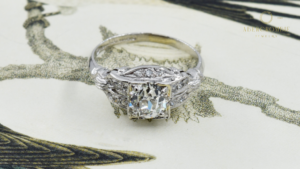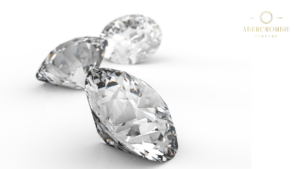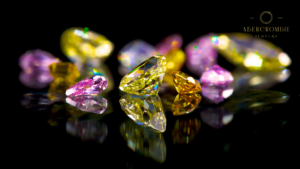Diamonds are precious stones long sought after for their beauty and value. Whether you’re just curious to know more about them or are contemplating a purchase or selling to a diamond jewelry buyer, it’s essential to understand the 4 Cs jewelers use to assess the quality of these stones.
Among them is color. You may not have realized this, but most diamonds contain trace elements, which can give them a subtle color.
In this article, we’ll delve into the specifics of the diamond color scale to help you understand how color affects the value of a diamond.







Understanding Diamond Color
Diamonds come from the earth, where they can pick up certain impurities. Furthermore, color differences can be attributed to variations in their chemical composition.
At this point, we must mention that while fancy-colored diamonds with intense colors (such as yellow, blue, or pink) are highly sought after, most diamonds are valued for their lack of color or for being within the near-colorless range.
Let’s take a closer look at some of the factors that affect a diamond’s color.
Structural Defects and Variations in Chemical Composition
Diamonds are composed of carbon atoms in a crystal lattice structure. Sometimes, structural defects occur in the lattice structure, which causes variations. These structural defects can alter the way diamonds interact with light, which leads to coloration.
The Presence of Chemical Impurities
When diamonds form, small amounts of certain elements can become trapped in the precious stone’s crystal lattice structure.
For example, if nitrogen becomes trapped in the diamond’s structure, it could result in a yellow or brown appearance. Should boron be the trapped element, on the other hand, it would cause the diamond to exhibit a blue color.
Irradiation
Radiation exposure through natural or artificial sources could also lead to discoloration.
Diamonds are sometimes exposed to natural radiation for many years and may experience color changes as a result. This alteration in color is brought about by changes to the diamond’s crystal lattice structure, which often leads to colors like green or black.
While many diamonds change color due to natural exposure, artificial irradiation treatment is sometimes used to alter the color for aesthetic purposes.
The GIA Diamond Color Scale
Diamond color grading takes into account the presence and intensity of color, and it is an essential factor in determining a diamond’s value and appeal in the market.
The International Color Scale was created by the Gemological Institute of America (GIA) to standardize the grading of diamond color. This scale uses a jury system to assess each diamond’s color and clarity. All five jury members must agree upon the grade for the diamond to be certified by the GIA.
Why Does the Grading System Start at D?
The grading scale starts at D, as the GIA previously utilized a grading scale that combined Arabic and Roman numerals and the first three letters of the alphabet. GIA began its system with the letter D to establish a unique grading scheme.
How Diamonds Are Graded
The official GIA scale uses letters from D to Z to indicate the grey, brown, or yellow amount in the diamond. Gemologists assess the color by setting diamonds upside-down on white paper to highlight color imperfections. The most colorless diamonds receive the highest grading.
Value and Application
A D-rated diamond is one of the most valuable, as it is a colorless and icy white diamond, while a Z-rated diamond has a yellowish hue. Typically, diamonds rated N through Z are not found in jewelry.
The Diamond Color Chart
Let’s look closer at the GIA color scale, starting with colorless diamonds.
Colorless Diamonds (D-F)
Grades D to F on the GIA diamond color chart denotes the highest level of colorlessness. Because contamination and exposure to radiation are so common, diamonds in this category are rare and appear completely colorless to the naked eye. They are considered the most valuable and desirable.
Near-colorless Diamonds (G-J)
G to J on the color scale represents near-colorless diamonds. While these precious stones may have a subtle color compared to higher-grade diamonds, it’s hard to detect in many cases without professional grading. These diamonds offer an excellent balance of quality and value.
Noticeable Color (K-M)
Diamonds in the K to M range exhibit noticeable color to the naked eye. These stones often have a light yellow or brown tint. Although they are lower down on the color scale, many find them the most appealing because of their character and warmth.
Brighter Hues (N-Z)
Last but certainly not least, on the GIA color scale are those diamonds with a more noticeable hue. They typically have a stronger brown or yellow tint. Generally, the precious stones in this range are considered lower in value than those with higher color grades. However, like the previous category, many prefer these diamonds because of their unique characteristics.
What About Fancy-colored Diamonds?
Fancy-colored diamonds are those whose color extends beyond the GIA color chart. This includes any diamond that is not white or colorless.
These brightly colored diamonds have a different grading system based on their unique color characteristics. Many are found naturally, while some are created in a laboratory setting.
Because of their rarity, fancy diamonds are very valuable and include many different colors. Even white diamonds with a sheen fall under this category.
The Influence of Shape on Diamond Color
Moreover, the diamond shape can highlight or entirely conceal a color variation. A diamond’s cut or form may enhance its brilliance because the facets illuminate the color rather than disclose any flaws in the stone itself.
In general, the round, brilliant diamond conceals color the best. It features multiple tiny facets, which lighten the hue beneath. More color is visible in diamonds with wide facets like pear, emerald, or oval shapes.
Tips for Purchasing a Diamond
Here are a few tips for finding the right diamond:
Don’t Just Look at the Color
When purchasing a diamond, you should consider the color grade in relation to other factors such as cut, clarity, and carat weight to make an informed decision. We also recommend setting a budget beforehand and having an idea of your preferences so that you know what to look for.
Think about whether a colorless diamond would be more appealing to you than one with a slight tint.
Consider the Ring Setting
Another thing to think about is the ring setting. If you have a higher-grade diamond that’s colorless or near-colorless, white gold or silver can really bring out its brilliance. In contrast, a yellow gold setting is recommended for diamonds with a grading of J and beyond.
Get a Grading Report from a Reputable Facility
You should also obtain a diamond grading report from a reputable gemological facility like GIA to ensure transparency and accuracy throughout the grading process.
Final Thoughts
Now that you understand the diamond color scale, you’re better equipped to make an informed decision about your purchases. Consider the other three Cs (cut, clarity, and carat weight) when taking your pick.
Frequently Asked Questions
Learn more about the diamond color scale in the FAQ section below.

